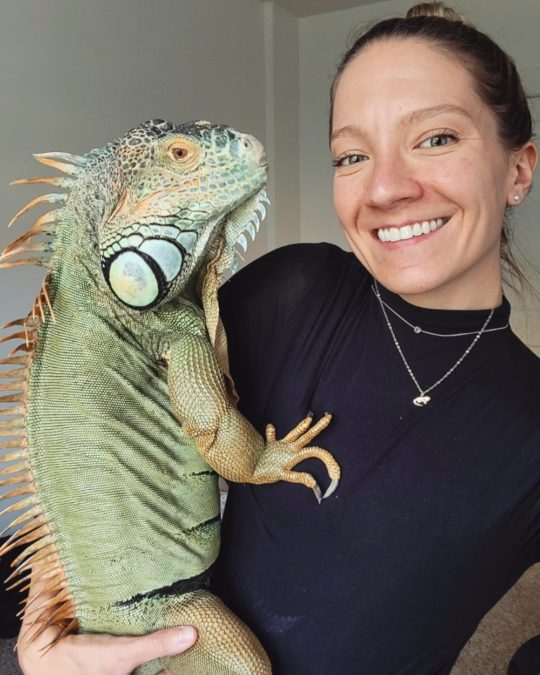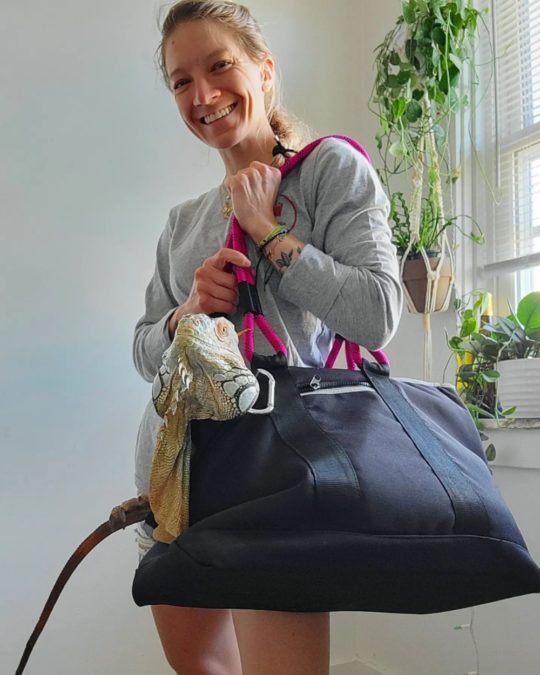
Even Though He’s Feisty and Destructive, This 5-Foot Iguana Managed to Find His Perfect Family
Lorren Kezmoh has always had a special connection with amphibians, reptiles, and other “creepy crawly” animals, especially those that typically get a bad rap. Her very first pet as a young girl was a turtle named Myrtle. She and her significant other currently live with three tree frogs, a Russian tortoise, a razorback Musk turtle, an Australian blue tongue skink, and a ball Python. So it should come as no surprise that a large green iguana also caught her eye a few years ago.
Blue the green iguana was found wandering around a Pittsburg park in the summer of 2016, likely abandoned there by owners who realized they were in over their heads taking care of him when he reached about 3 feet long and wasn’t done growing. Animal control brought him to the shelter where Lorren was working at the time.

“I had actually just started in marketing and walked past his tank that they were keeping him in one too many times,” she recalls.
Lorren wasn’t originally planning on adopting Blue the green iguana, but a new iguana had recently arrived who needed his space. So with a little prompting from her coworkers, Lorren was convinced to add Blue to her ever-growing menagerie of “expensive kids.”
Many people wonder why an iguana like Blue can’t be returned to the wild, and the answer is complicated. It’s illegal in the U.S., for starters, and this isn’t the green iguana’s natural habitat. Iguanas would not thrive in most of the U.S., and even if they could, having an invasive iguana population could disturb the ecosystem and disrupt the food chain.

There are also international trade laws in place that prohibit or severely restrict the transfer of certain species between countries, which Lorren says would make it difficult to send Blue back to Central or South America, where his species typically lives. Animals that were born and raised in captivity are also often incapable surviving in the wild. So Blue had to have a human caretaker.
Lorren had never cared for an iguana before, so finding him a suitable enclosure and learning about his specific needs was quite an undertaking. Blue requires a varied diet of fresh plants, the perfect humidity and temperature, access to UV lights, sufficient calcium and vitamin D, and more.

There was also a bit of a learning curve regarding Blue’s temperament. Many types of snakes and reptiles are bred in captivity for so many generations that they begin to adapt to domestic life and act like well-behaved pets, but that isn’t the case for green iguanas like Blue – he’s very much still a wild animal at heart and isn’t very trainable. Lorren says Blue can get aggressive, particularly during mating season, and won’t hesitate to bite the hand that feeds him if he’s in a mood.
“There are times during breeding season where he’ll chase me around the apartment, or if I’m wearing a certain sweater, or if I’m carrying laundry. He really does not like tie-dye. He hates flannel patterns. He’s threatened by the color orange in any any hue. If he sees that, he’ll come charging after me, and there’s no amount of saying ‘no, stop that’ that’s gonna get him to stop.”

Sometimes, Lorren has to physically block Blue, who is now five feet long, to manage his behavior. Other times, she just gives up and gives him the item he’s after.
“There are several items in our apartment that have suffered at the the mouth of the iguana just because he’s decided that is what he wants to attack or befriend for the day. And once he gets it in his mouth, you don’t get it back until he is done with it,” she says.

Lorren has to read Blue’s body language (he likes to “talk” with head bobs) and know when to give him space and how to handle him properly. She’s also had to adapt and make adjustments such as buying cheap furniture and extra carpeting that are allowed to be damaged. She also had to get rid of Blue’s enclosure when he became overly defensive of it in order to decrease his aggressive behavior. Luckily, however, Lorren finds Blue’s stubbornness to be one of his most endearing qualities.
But for the most part, Blue is fairly docile and a wonderful pet. He’s been around humans a lot and isn’t phased by crowds and noisy areas. He spends much of his time in Lorren’s home office, where his heating pad and UV light are, but he also likes to explore the rest of the house, nap in the sunshine, climbing things, soak in the bathtub, cuddle on people’s laps, and go on occasional outings.

Lorren, who has spent much of her life working and volunteering at zoos, wildlife centers, and the like, loves to take Blue to work with her on occasion, where she teaches STEM subjects at a science center in Pittsburgh, Pennsylvania.
“Dogs and cats are great and fine, but everybody already loves them,” says Lorren. “It’s it’s time for reptiles and a lot of other animals to get their little bit of time in the spotlight.”
Blue has been a very successful reptile ambassador, teaching people about how cool reptiles and rescue animals are.

“He has his own little lab coat and a bow tie. We make him look as official as possible. And occasionally he does work the reception desk and the admissions desk, answering questions to the best of his ability. It’s a kind of enrichment for him. So I do educational programs with him, but it’s also a new experience for him. So he gets to meet new people, he gets to walk around in a new environment that he doesn’t see all of the time.”
We’re so happy this stubborn and charismatic boy found his perfect match and is now living the dream life! Blue, keep showing the world how great reptile rescues are!
Help Rescue Animals
Provide food and vital supplies to shelter pets at The Animal Rescue Site for free! →